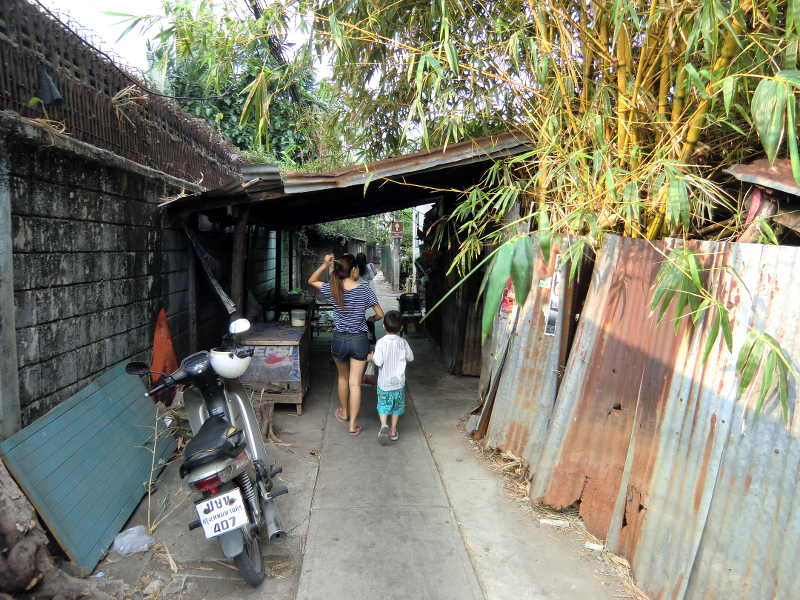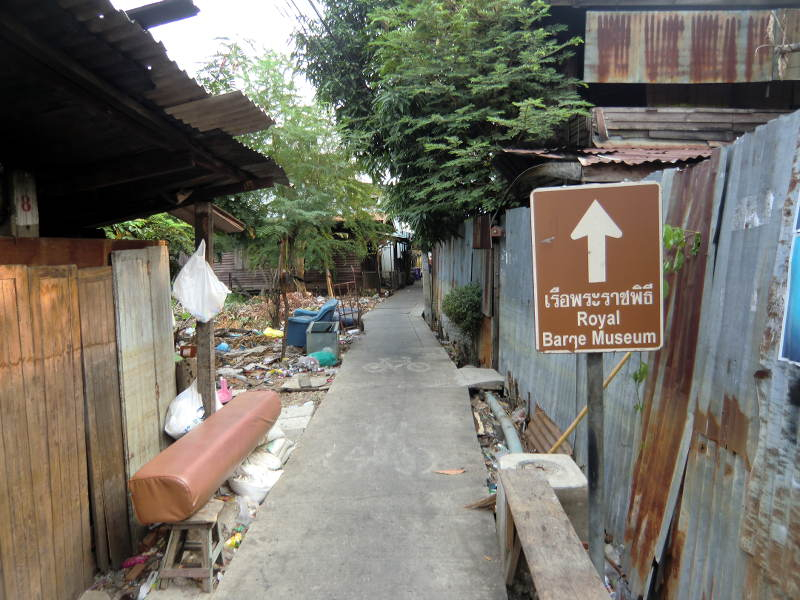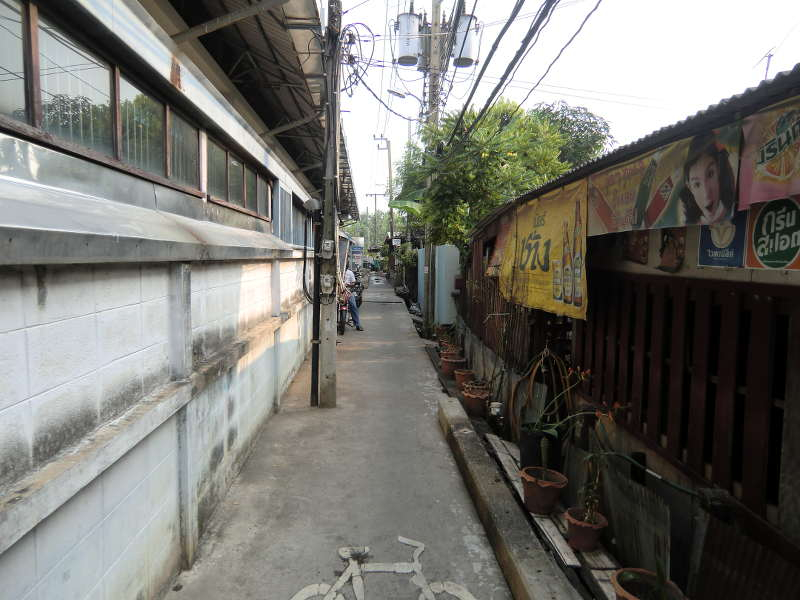We are off on a new adventure!

We'll land in Bangkok and a few days later fly north to Chaing Mai. From there we'll head farther north through the heart of rural northern Thailand exploring and discovering local culture and life of the hill tribes. We'll see a variety of hill tribe groups as we travel to Chang Saen, Karn, Doi Angkhang, Pai, Mae Hong Son, Mae Chaem and Mae Wang.
Bangkok
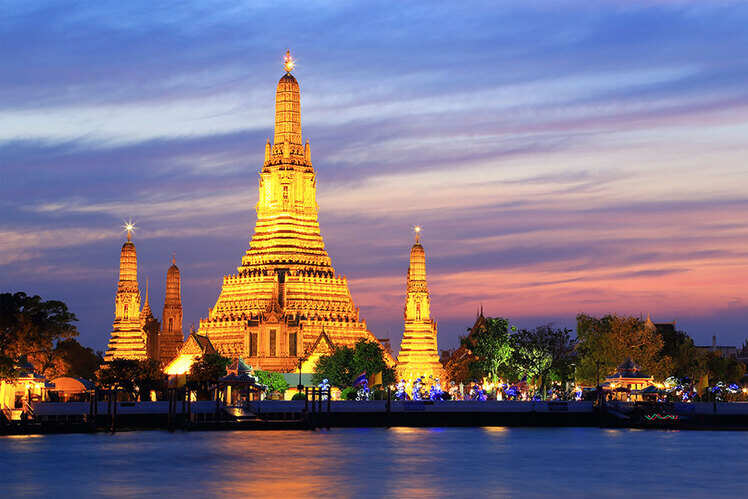 |
We departed Seattle January 27th, 2020 and landed in Tokyo, Japan, 9 hours later.
After a 4 hour layover, we flew 7 more hours to Bangkok, Thailand.
All totaled, from the front door of our home to our Thailand hotel room, we had traveled over 25 hours and 7,349 miles. By crossing the International Date Line on Monday the 27th of January, we arrived in Bangkok on Wednesday, January 29th. Bangkok is ahead of Seattle by 15 hours. We'll have to keep that in mind when we text our family and friends!
As we checked into our lovely Novotel Hotel early Wednesday morning we saw this poster. We'll have to remember that here in Thailand, the Super Bowl is on Monday not Sunday! If we want to see kick off, we'll have to get up early on Monday, for it airs at 6:30 AM.
******************************************************
Three Days in Bangkok
 Bangkok, otherwise known as Krung Thep, the "City of Angels", is a vibrant, urban, sprawling city of over 9.5 million people. Bangkok also has an inordinate amount of stunning historical temples, amazing gold leaf Buddhas, an intricate network of canals and rivers, lush green parks, world-class restaurants, delicious smelling street food, including one of the largest markets in the world. Thailand is called the "land of smiles" and Bangkok certainly showed us 3 days of beautiful weather and sunny smiles.
Bangkok, otherwise known as Krung Thep, the "City of Angels", is a vibrant, urban, sprawling city of over 9.5 million people. Bangkok also has an inordinate amount of stunning historical temples, amazing gold leaf Buddhas, an intricate network of canals and rivers, lush green parks, world-class restaurants, delicious smelling street food, including one of the largest markets in the world. Thailand is called the "land of smiles" and Bangkok certainly showed us 3 days of beautiful weather and sunny smiles.Each day we took the airport rail link to the BTS Bangkok sky train. From there it was a short walk from the Saphan Taksin BTS station to the Chao Phraya River. We also rode the subway every day to the Sanam Chai Station, which is stunning!
Here are a few photos of the interior of the station.

The red and gold offer a sense of "exquisiteness and elaboration" according to the principles of Thai architecture.
The Sadhum pillars adorned with tiles of lotus flowers are covered with gold leaves and practically shimmer in the interior lighting.
The station's floor and walls resemble the historical city wall

while its ceiling has been designed in a spectacular star and moon pattern which are adorned with cotton rose flowers.

The Sanam Chai Station's location is surrounded by Thailand's holy sites and prestigious attractions such as the Grand Palace, the temple of the Emerald Buddha, and Wat Phra Chettuphon Wimon Mangkhalram. The station also provides highly convenient access to Saranrom Park, the Pak Klong Talat (Flower Market) to name just a few tourist attractions within walking distance.

with boat traffic zig-zagging around.
There were also large barges with cranes!


We passed by some high rent areas

From our top deck seating, we were able to view the astounding temples from the water's edge.
We crossed the Chao Phraya River over to Bangkok Noi Canal by ,walking across the heavily trafficked bridge and wound around through the streets until we found the market place wishing us a Happy New Year

with a monk and his iPhone.
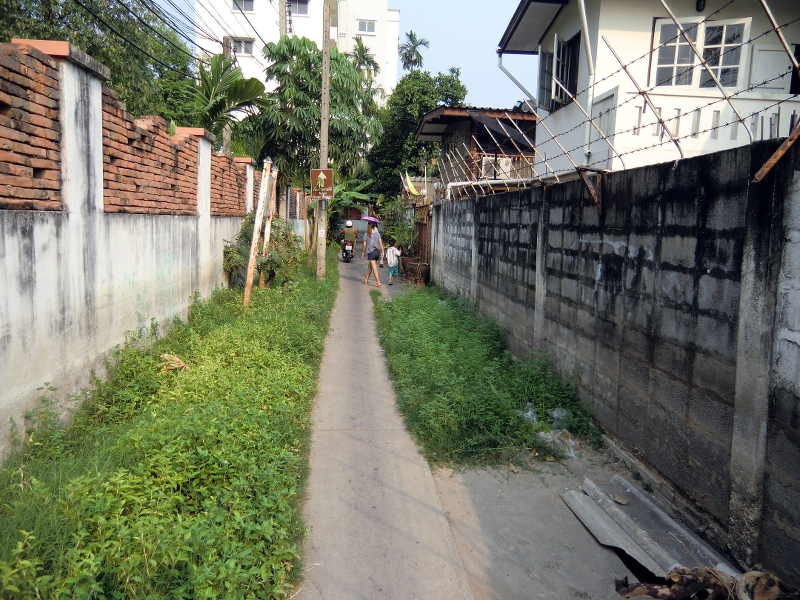

Photos taken prior to World War II simply do not do the Royal Barges justice.


This infrequent flotilla dates back 700 years and has been witnessed only 15 times in almost 90 years as both a religious and political event.
The most recent time in the past 90 years occurred this past December. The Thai Royal Barge Processional was part of the final ceremonies for the Royal Coronation of His Majesty King Maha Vajirdonghon.
We were thrilled to see the 8 Royal Barges housed in the 'boathouse". Each one is a sleek and slender, fantastically ornamented vessel with exquisitely hand-carved, elaborately decorated, hand painted and finished in gold leaf. These historical barges are both graceful and yet foreboding with the cannon expertly concealed under the bow.
We were greeted by the door by the Asura-Vayuphak or the half giant-half bird Royal Barge.


This Royal Barge is the shortest being
6 feet wide, 100 feet long, and 6 feet deep.
During the processions, it carried
40 oarsmen, 1 officer,
2 steersmen, 1 standard bearer signalman,
2 station markers, and 10 drummers.
Of the 8 Royal Barges, there were a total of 400 oarsmen over 1,200 courtiers.
Here is a December 12, 2019 photo of the Asura-Vayuphak Royal Barge.
From inside the boathouse to majestically being rowed on the water.



The longboat has an outboard motor and flies through the water.

Here's what the interior looked like:

We were low to the water!
Along the way, we slowed down as we passed this humble home.

This lovely gentleman rowed his longboat over to our boat and asked if any of the passengers wanted snacks(he had lots of pringles and candy bars!), water or beer.
Wat Pho and the Reclining Buddha

We wore our masks each day whenever we were on the subway, train, or walking throughout Bangkok. We only took our masks off to eat! At the time we were in Bangkok, there had not been any reported cases in Thailand of the Coronavirus which originated in Wuhan, China. Nonetheless, no one was taking any chances. Virtually everyone on the subway, trains, and markets were wearing some variation on the masks.
We were impressed with how orderly the subways were. Passengers lined up on the
Of course the policewoman on hand helped.


We strolled by the 91 stupas.

Each one was exquisitely made of ceramic.



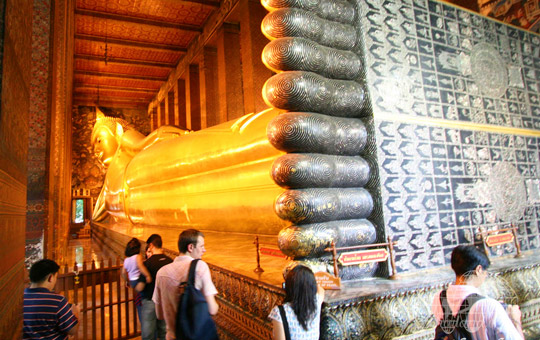
This reclining Buddha has massive feet with each positioned one on top of the other. The long projections of the 10 toes jut outward and even have swirled toeprints.

The reclining Buddha's feet are 16 feet long.


They are exquisitely illustrated with mother of pearl inlay.

There are 108 illustrations representative of the 108 positive actions and symbols that helped lead Buddha to perfection.
There are even swan paddle boats to while away the afternoon.

Throughout the park, there are both historic

and modern buildings which are constructed the traditional motif.
Chiang Mai
Here's the view from our room

All total, we will be in Northern Thailand for 15 days, 5 of which we'll be in Chiang Mai, the land of "misty mountains".
The other 10 days, we will be traveling north into the mountains to the border of Thailand/Laos/Myanmar. We will be visiting the colorful hill tribes and will even experience a homestay.
Located in a verdant valley on the Ping River, Chiang Mai is the largest city in northern Thailand with its population of 131,000.
The name Chiang Mai means "new city" for it was founded in 1296. In 1997, Chiang Mai celebrated its 700th anniversary. As the guide book says, "Its Old City area still remains vestiges of its walls and moats from its history as a cultural and religious center."
Our first day we took a private walking tour of the old city, which is sprawling. We enjoyed this walking tour for it was a great way to get a feel for the city and to learn about its history.
One of the first things we learned is that Chaing Mai is known for its delicious coffee and amazing latte art!

We walked past the fortress of the city which was built in 1800. We learned that "the plan called for a square formed by moats and walls that faced the cardinal directions". So they built a wall constructed around the moat.
We walked to Thapae, one of the original 5 gates of the fortress around the Old City. It is located on the eastern side of the old city fortress.

We also walked past the ubiquitous Thai Massage Parlors. It seemed as though signs such as the one below lined the streets.

One in particular caught our attention.

It was the only massage center that we saw that had a TripAdvisor certificate of excellence!

It was the "Woman's Massage center by
Ex-Prisoners"!
Our guide took us to another part of the city to see the woman's prison
which is actually the spot where some prisoners come each day to sell their hand made items which they have learned how to
make in prison. In prison, they are taught to sew and to administer Thai massages so they'll have the means to support themselves when they are released from prison.
In addition to selling their hand made items, they also serve food at their little cafe.

Each night the ladies return to their prison cells on the outskirts of the city. But for many, their days are spent in this lovely place, filled with birds and flowers... a little oasis in a bustling city street.


Afterward, we toured various temples and learned the symbolism of the exquisite dragon being consumed by the crocodile guarding the entrance of the temples.


the roofs of the temples.

So many of the temples are still brilliantly illuminated with inlaid reflective colored glass which glistens in the sunlight.
Our guide took us to see numerous brick relics such as this 600 year old temple.

We also saw any temples that were under renovation.

So often, the side streets were lined with lovely temples, many of which had monks inside.




Wat Phra That Doi Suthep

Today we had a private guide who had been a monk from ages 13-19. We learned that one can be a monk for either a portion or all of their life. Our guide, Kip, provided a fascinating insight into the daily life of a Buddhist monk. He also gave us an amazing explanation of the temple's artistic religious symbols and even taught us Buddhist meditation methods. It was a profound experience.

This method of local travel is a converted pickup truck with two benches in the back facing each other. The red ones (also known as "rot daang" meaning "red truck") operate in the city center. Flag one down, ask the driver if he's going in the direction you want and ask the price. Then hop on, or hold on as the case may be, and you're off.

Kip arranged for the red "songthaew" to take us up the mountain to the entrance to Wat Phra That Dio Suthep. The songthaew definitely was the way to go the distance for us today. It was quite an experience.
Kip told us about his monastic life. One of the many takeaways for us today was the Buddhist philosophy of "Eat to live, not live to eat". Wise words indeed!
As we approached Wat Phra That Doi Suthep, we were met by a long staircase of 306 steps. This staircase is flanked by a stunningly beautiful mythical creature of "Naga". The Naga is a half serpent (dragon) emerging from the mouth of a crocodile. It is to protect the holy area.


The 306 long stair-stepper climb up to the temple is intended to help devotees accrue Buddhist merit. So up we went.



Wat Phra That Doi Suthep was established in 1383 to enshrine a piece of bone said to be from the shoulder of Buddha. In a sacred ceremony, a monk broke the bone into two pieces. The other one is enshrined in Wat Suan Dok. The second fragment was mounted on a sacred white elephant

that wandered through the jungle up the mountain for days with the devotees following close behind. The elephant journeyed to the top of the mountain where, as the legend goes, she laid down and died. It is that very spot where the monastery was founded.

The relic is housed in a "chedi" surrounded by an array of gleaming gold-leafed Buddhas.
Pilgrims wait patiently in line to offer lotus blossoms.

The sunlight today gave the shrines surrounding the "chedi" a beautiful, glowing golden hue. The statues of Buddha that surrounded it were in an abundance of different poses.

We were given the opportunity to be blessed by a monk and greatly appreciated the kindness.


Wat Phra That Doi Suthep is a massive area filled with smaller shrines.



We spent hours walking on and through the various shrines and temples. Soon it was time to go. As we were walking down the 306 steps of the long stairway,
Kip hailed a songthaew and it drove us halfway down the mountain to the beginning of a dirt road. This "road" is easily overlooked as one is driving up the mountain to see the popular Wat Phra That Doi Suthep.
Kip said that we were now walking on the to the lesser-known Wat Pha Lat and it is a hidden gem.
Before one gets to the entrance to Wat Pha Lat, there is a coffee stand!
It had this sign on the counter so of course we all ordered an iced boon coffee and contributed to the monks' dental plan.

It was a great cup of coffee and its cup holder was made out of a palm frond. But most of all, we especially loved the words on the coffee cup:
"Be Happy. Enjoy the little things."
Kip told us that Wat Pha Lat is nestled in a lush green jungle temple paradise. We learned that "a jungle temple is different than a community temple. Jungle temples serve primarily as a calm place for monks to live and meditate".
The entrance to Wat Pha Lat is guarded by these magnificent, massive statues.

We entered old stone temples laced with intricate carvings and statues. Each temple had steps leading to the entrance and huge symbolic statues protecting the temple.



Kip led us to the cave where a hermit monk, who had taken the vow of silence, lived his entire life.

Kip also showed us a cave that had monk statues carved into the walls of the cave. Devotees have shrouded these silent monks in golden robes and have laid offerings outside the cave.
Most of all Wat Phra That's jungle temple area provided plenty of scenic spots to meditate.

Chiang Mai can be seen in the valley below. There's a path to a hiking trail that leads to the city below and can be done in under an hour.

It was in one of those breathtakingly beautiful viewpoints that Kip taught us how to calm the "monkey brain" and to walk in meditation as the monks learn to do.
Walking Around Chiang Mai
There were vendors selling virtually any and everything one's heart could desire.
First by the entrance was Mrs. Tavee Saeheng"s one stop shopping...pedicure and Thai massage. There were plenty of takers.

Beside the pedicure and Thai areas, there were vendors selling their wares.
Handmade items 100 baht is $3.00 and 150 baht is $5.00

Masks were very popular! 20 baht is 67 cents.

There were some beautiful creations

If you want your purchase altered, there is one on-site who can help you.

There are shoes galore! 109 bahts is around $3.50 US dollars.

These lovelies are handmade soaps in the intricate shapes of flowers. They were so beautifully made.

There also was every type of food one could enjoy from the "yummy food tastes so great" stand


to fresh seafood

and fish that has been smoked.

to meat kabobs next to vegetarian delights
to popsicles


The pizza stand was also popular although it was not like our pizza. It was Vietnamese pizza.
The jelly coconut stand was hugely popular.


Directly beside the cricket stand was a dessert stand with a beautiful array of confectionary treats.
If you were interested in skateboards, there was a vendor there to help you part with your money.

All too soon it was time to head back to our Chiang Mai home away from home, The Green Tiger House. We needed to get packed and head for bed for tomorrow we start our 9 day journey north to the Hill Tribes.
########################################################################
LAHU Northern Thailand Hil Tribe
and the AKHA Northern Thailand Hill Tribe
Thailand's Hilltribes ~Lahu and Akha
Thailand's Hilltribes ~Lahu and Akha
to help grow their crops.

Thailand's Hilltribes ~Lahu and Akha
Houses in this hill tribe village are built of bamboo, wood, and grass.

~~~~~~~~~~~~~~~~~~~~~~~~~~~~~~~~~ The following day we drove to another remote location in the mountains to visit the
*********************************************************************************************************
Thailand's Hilltribes ~Lahu and Akha
Akha hill tribe of Ban Lorcha:


The swing festival takes place sometime between August and early September. The actual date is determined by the village shaman. The swing festival coincides with the rice harvest and is performed to give thanks to the spirits.






Palong Hill Tribe

There are very few members of the Palong northern Thailand hill tribes. The Palong fled from Burma (now called Myanmar) to Thailand between 1982 and 1984. They escaped from the violent Burmese government forces and rebel armies. They fled to the high Doi Angkhang mountains which border Thailand and Myanmar.
Before we visited the Palong tribe we stopped at the Thailand-Myanmar border crossing.
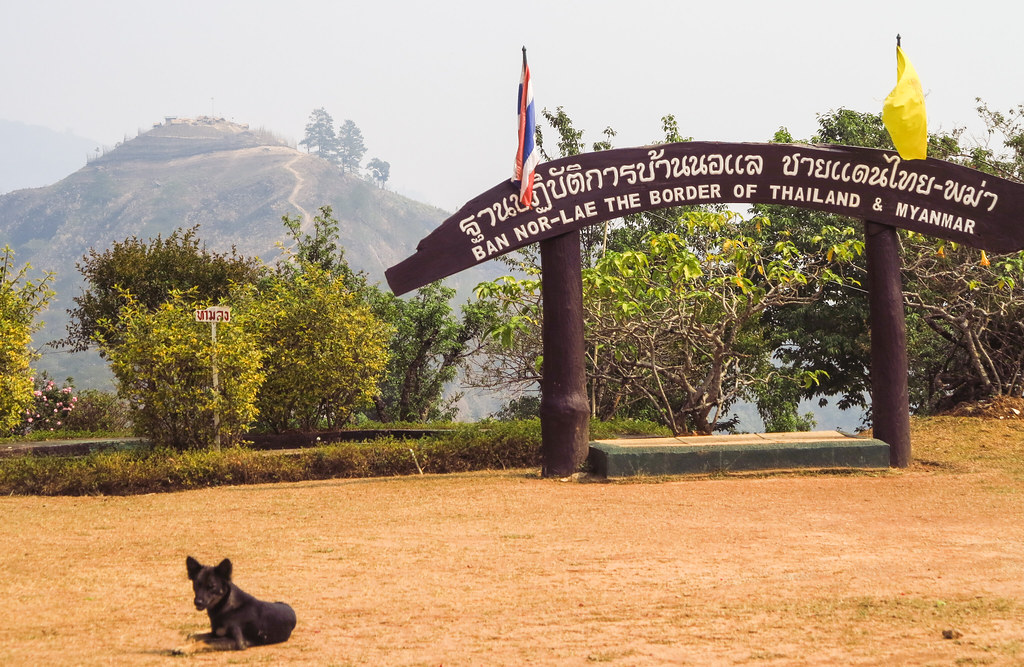
There is a strong military presence at this border with soldiers and barbed wire fences with bamboo spikes.

The culture of the Palong is similar to the other northern Thailand tribes. They are very spiritual and deeply believe in "animalism". This is the belief that all objects, places, plants, creatures, weather systems, rivers, human handiwork, and even words possess a distinct spiritual presence and are all alive and animated.


The women all wear brightly colored jackets. The majority of the jackets are blue or black, while others are green or purple. The jacket style is similar to that of a bolero. Regardless of their color, all jackets have a bright red collar. The women wear a long skirt that is red and patterned with thin white horizontal stripes. It is worn like a sarong.
But the most striking part of the Palong women's clothing is a wide silver waistband. This wide silver waistband is one piece. To put it on each morning, the women step into it and shimmy it up towards the waist. They then put on a wide black belt to help keep it in place.



We saw women roasting corn.



tribe grow strawberries. Row upon row of strawberries on the mountain slopes. This is a cash crop to replace opium.
The Oldest Palong hill tribe's
man and woman
man and woman



The older gentleman strummed it and sang two songs to us before his voice gave out.



It was a very special time with these two gentle, loving people. We were there for a long time and they said they were sad to see us go. They wanted us to come back soon.
~~~~~~~~~~~~~~~~~~~~~~~~~~~~~~~~~~~~~~
Karen Hill Tribe Homestay
~~~~~~~~~~~~~~~~~~~~~~~~~~~~~~~~~~~~~~
Karen Hill Tribe Homestay
~~~~~~~~~~~~~~~~~~~~~~~~~~~~~~~~~~~

The "household" chores are the responsibility of the Karen women.

In the photo below, one of the Karen women is carrying water in her jug up to her home.


The members of the Karen hill tribe went out of their way to make us feel comfortable. We transitioned into a very peaceful, quiet way of life.
~~~~~~~~~~~~~~~~~~~~~~~~~~~~~~~~~~~~~~~~~~~~~~~~~~~~~~~~~~~~~~~~~~~~~~~~~~~~~~~~~~~~~~~~~~~~
LONGNECK HILL TRIBE
and the BIG EAR HILL TRIBE
~~~~~~~~~~~~~~~~~~~~~~~~~~~~~~~~~~~~~~~~~~~~~~~~~~~~~~~~~~~~~~~~~
Longneck Hill Tribe and the Big Ear Hill Tribe

Our boat was long and quite narrow. Its bow was a good 4 feet off the water.

As we donned our lifejackets, they pulled the boat closer to shore. We hopped aboard.
The only other passenger was the fisherman's relative who was perched on the elevated bow of the boat.
The fisherman powered his narrow boat with a huge motor. The motor was from either a tractor or a car.
Attached to this high powered motor was a propeller that looked like a weed eater on steroids.
Perhaps you can see, at the bottom of the photo below, the long propeller that is sticking out from the motor mounted on the back of the boat.
The fisherman's relative, who was precariously perched on the bow of the boat,
As had been our experience in other hill tribe villages, the Longneck village had a peaceful, relaxed sense of calm.
Soon we saw a lovely woman sitting on a bench, strumming her handmade wooden instrument which resembled an antiquated guitar. As we approached, we heard her softly singing.

She stopped singing and motioned for me to come over and sit beside her. Then she serenaded us with many beautiful songs. It was irrelevant that we didn't know Thai nor that she didn't know the English language. Her beautiful melodic words transcended the language barrier.

The Longneck tribe members fled from religious discrimination, political oppression and civil unrest in Myanmar (formally Burma) to the safety of Thailand. While fleeing for their lives and crossing the border to the safety of Thailand was obviously the right choice, it created an economic problem for the Longneck Kayan hill tribe. In the eyes of the Thai government, they are illegal immigrants. Consequently, the Longneck's opportunity for gaining Thai citizenship is extremely limited to none.

We learned that the neck rings are actually one long piece of brass coil that is wrapped around the neck. As one gets older and requires more rings, that piece of coiled metal is removed and then a longer brass coil is wrapped around the neck to add more rings. Since the coils do not lengthen the neck, the coils can be removed without breaking the woman's neck. However, the neck muscles are so weakened and atrophied that the neck needs to be firmly supported and held in place when the new, longer brass coil is added.
Longneck women wear these coiled rings throughout their life. Starting at ages 4 or 5, a coil is added annually until the child acclimates to the increased weight.
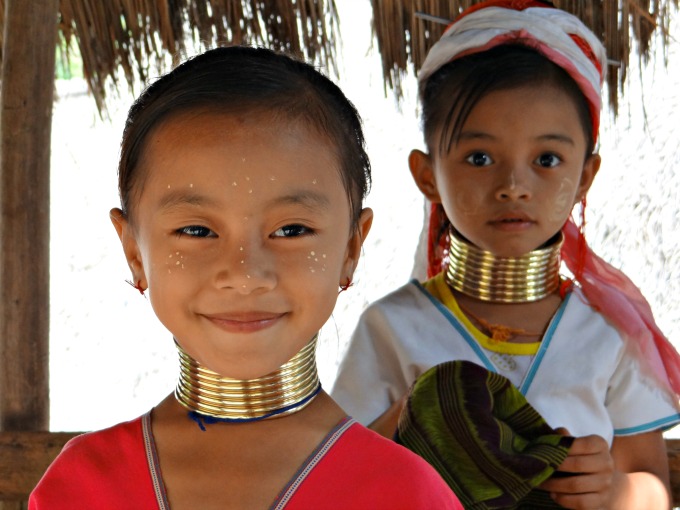
With very few exceptions, the coils are never taken off. They are worn year round, even when sleeping!

These rings on the neck, wrists, and knees of the long neck women now are considered a traditional mark of beauty. It is believed that long ago these rings were worn to protect women from tigers.
Our guide took us into the hills and one such fig gatherer passed us.
Our guide took us to the Kayaw hill tribe known as "Big Ears". We saw a Big Ear woman working on threading the fig leaves together.
This lovely Long Ear woman was busily inserting long strips of bamboo through the fig leaves.

On her right is a pile of the large fig leaves which have been woven into strips.

As she weaves the fig leaves together, she is creating the equivalent of shingles for the roof of houses.

While she was very dear to have the three of us in a photo,

it's plain to see that she MUCH preferred to be in the photo alone with Jeff.

It was an amazing day and all too soon it was time to go. We said our warm good-byes and headed to the riverbank. Our fisherman and his relative helped us board his boat.
The sun was setting as we motored our way downstream back towards civilization. Our time with the Longneck and Big Ear hill tribes is a day we'll never forget.
Elephants!
The Elephant Rescue Park is located in a lush green valley on the outskirts of Chang Mai. The park's primary objective is to rescue elephants abused from circuses and logging camps. This Rescue Park provides the elephants with a safe, loving, and secure environment. The goal is to keep these elephants healthy and happy by providing a natural habitat within which they can enjoy the rest of their lives.
In case you're wondering, the purchase price to rescue an abused elephant is between $60,000 to $80,000 US dollars. By Thai standards, this is an enormous amount that few can afford.
Throughout our day at the Elephant Rescue Park Chiang Mai, we felt the elephants were treated with kindness, respect, and love.
We were with one elephant who had arthritis in her back legs. For 20 years, this elephant worked in a teak logging elephant labor camp pulling one-ton teak logs an average of 20 times a day. That's 20 logs of 2,000 pounds each. This elephant had been pulling 40,000 pounds each and every day.
To help ease her arthritic pain, this elephant received glucosamine in her daily vitamin balls. Glucosamine is unavailable in Thailand. So these glucosamine tablets are imported in huge shipments from the United States. The brand? Why it's the Kirkland brand from COSTCO!
During our time at the Elephant Rescue Park, we learned many fascinating facts about elephants. Did you know that elephants are herbivores and that eating ripe bananas, leaves, bamboo and fruit consumes 18 hours of the elephant's day! A female Asian elephant, called a cow, weighs over 6,000 lbs. She can consume 336 pounds of food a day!
A male, or bull elephant, is around 8,800 pounds. He eats 422 lbs of food per day!
Because elephants also do not eat in unclean surroundings tainted by dung, their instinct is to roam to a new area to eat.
Another interesting tidbit about elephant dung is that elephants can only digest 40% of their daily food which results in 60% elephant poop. For a female Asian elephant poops 202 pounds of poop daily and a male poops 253 pounds per day!! That's a lot of poop!
Then we met our elephants!
They came walking down to meet us.

They are enormous and it is easy to see why they are the world's largest land animal.

We were also instructed to touch the elephant's hide by petting it as hard as one would pat the head of a dog. If one pats the elephant with a very gentle touch, the elephant will think you are an insect and swat at you with its massive trunk.
We had an amazing time feeding these gentle giants.
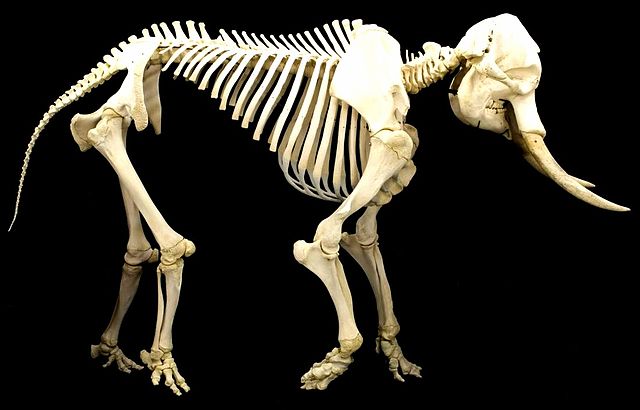
Amazingly, while not having a bone, the elephant's trunk does have a staggering 40,000 muscles and 150,000 individual units. Our human body only has 639 muscles. You can see how intricate the elephant's trunk is.
The trunk is used for smelling, touching, grasping objects and food, producing sound and of course, breathing.
Elephants are the only animal that can snorkel without artificial aid. By holding the tips of their trunks above the water's edge, elephants can traverse a river being totally submerged. They simply walk across the riverbed.

And believe it or not, elephants can suck up 10 gallons of water per minute!


We learned that elephant trunks are like our fingers. The Asian elephant's trunk has one "finger". That's why it must wrap its trunk around objects like a boa constrictor.
One does not feed an elephant as one feeds a horse where you place the food on the palm of your hand for the horse to eat. With an elephant, you never hold the food, such as a banana, in the palm of your hand. You hold the banana upright and the elephant will grab hold of it.



PooPoo Paper
Asian elephants come in three different colors: brown, grey, and black. Their skin feels like leather.
Their life span is between 55 to 70 years.
The Asian elephants' top speed can reach 27 miles per hour. In parts of Thailand, it's challenging to share the road with an Asian elephant! This elephant charged out of the jungle and onto the road to chase the Toyota! This photo was taken in the Khao Yai National Park.
The Asian elephant's height can be between 7 feet to 10 feet.
Asian elephants can weigh from 6,500 lbs to 11,000 lbs! They eat over 18 hours in a day.
You and I eat only 3 or 4 pounds of food a day. An average female Asian elephant, called a cow, consumes nearly 350 pounds of food per day. A male or bull elephant, eats nearly 440 pounds of food a day.
And, are you ready for this? A female Asian elephant poops 202 pounds daily! A male poops 253 pounds per day!!
We enjoyed our interactive experience making the Poo Poo paper. Creating the Poo Poo paper products from elephant poo illustrated the important message of conservation and sustainability.
The process of making Poo Poo paper has to be seen to believe it, so here are a few photos:
Poo poo fibers

The first step in the process of transforming elephant poo into everyday paper involves scooping up the poo. Once the workers have gathered it, they wash away the waste. All that's left are the plant fibers.

Believe it or not, the poo is odor-free and is dried in the sun for 2 days. It feels like hay.
The dried poo is then boiled for several hours to become completely sterilized. This is a manual process.


Back to the process of making the poo poo paper: one starts pressing and smoothing the colorful, soft, gooey mass evenly on a mesh screen board (similar to a silk-screening board). The board is then set in the sun for drying.

Once dried, we could easily remove it from the screen. The trick is to be patient and not tear it. And voila, poo poo paper!
After the hands-on tour, we made colored poo poo paper photo frames, diary covers, and cards.

Of course, there were items for sale, such as the ones below. All proceeds go toward the care for the elephants at the Elephant Rescue Park.

We created a poo poo paper photo frame. It will be a lovely, lasting memento filled with photos of our amazing, memorable day with the astounding elephants of the Elephant Rescue Park Chaing Mai.
THE MOKEN TRIBE
ON THE SURIN ISLANDS
~~~~~~~~~~~~~~~~~~~~~~~~~~~~~~~~~~~~~~~~~~~~~~~~~~~~~~~~~
The Moken Tribe on the Surin Islands
The Surin Islands are located in the Andaman Sea, 38 miles west of the mainland of Thailand and 6 miles from the Thailand-Myanmar border.
The Surin Islands are one of the very few untouched places in Thailand. Aside from the national park premises and the small Moken village, there are no other buildings on the 5 Surin islands.


We saw a beautiful hawkbill turtle and swam with her for quite a while. It was magical.

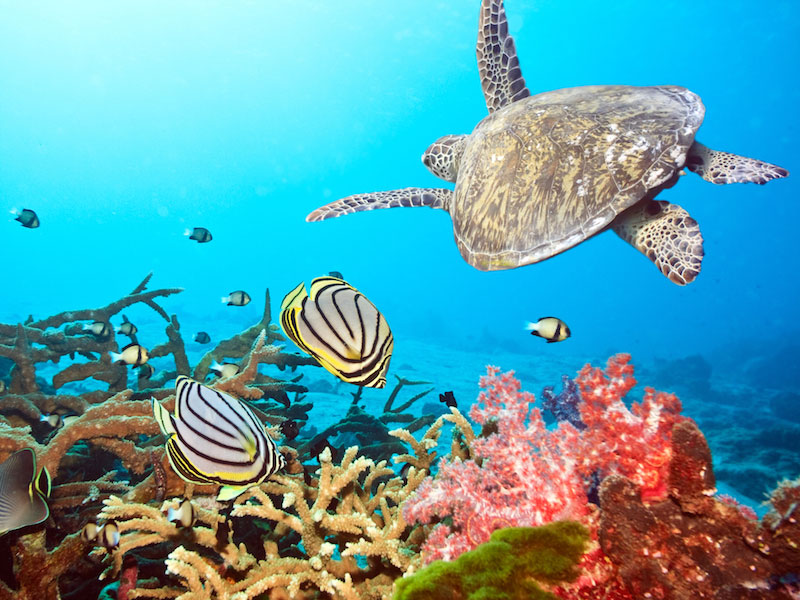




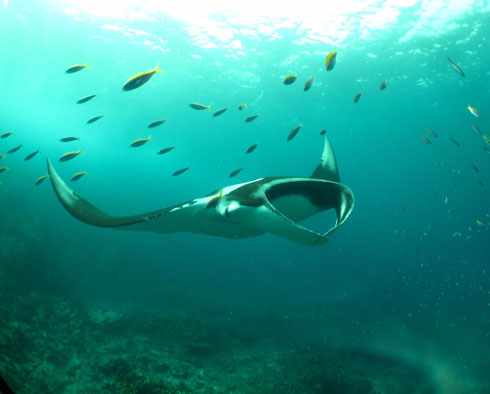

Our Moken guide's village lines the shore.

To the Moken, the sea is their universe. For hundreds of years, the Moken were called "chao-lay" or "sea gypsies" for they lived a semi-nomadic life relying heavily on the sea. Until the 1981, whole families of the Moken would spend of their entire life living in their boats, called "kabangs",

traveling from bay to bay throughout the Surin islands, living on shellfish, sea cucumbers, and fish.

The Moken are very spiritual and practice "animatism". This is the belief that all objects, places, plants, creatures, weather systems, rivers, human handiwork, and even words possess a distinct spiritual presence and are alive. To them, all the world is animated and filled with spirits.
This sacred shrine, located at the village entrance, is flanked by these carved, painted wooden poles called "spirit poles". They are sacred symbols which the Moken believe enable them to communicate with the spirits.



The Moken speak a unique native language, yet they have no written language. Their oral history is passed from generation to generation in folklore, legend, and songs.
It is particularly noteworthy that some words which are common in Western languages do not have any equivalent in the Mokan language. For instance, the Moken have no word for "worry". Other words that do not exist in the Moken language are "want", "take" or "mine" which is reflective of their culture of sharing and giving. The concept of individual possession of the land does not exist.
In 1981, the 5 Surin islands were established as the Mu Koh National Park, bringing profound changes to the Moken way of life. Government restrictions were placed on how much the Mokens could hunt and gather from the reefs, beaches, and forests in this newly "Protected Area" of the National Park. For instance, now the Moken are not permitted to cut any trees. So there is no wood with which to build their kabong boats. The art of making a kabong is literally dying out with the older generation. In addition, the Moken are also limited to the number of fish they can kill.
The kabong is at the heart of the Moken's former life, seen as part of the family. Their innate way of life, living as sea gypsies, traveling in kabongs, and living off of the bounties of the sea are now prohibited because their islands and the Andaman Sea surrounding each island are a "protected area" owned by the Thai government.

Nowadays the Mokens are permanently located in a small village built on stilts on the water's edge on the Surin island of Koh Surin Nuea.
The Moken village was rebuilt in 2005 by Thai government assistance which brought in generators for electricity. They restructured the Moken village with an emphasis on western housing. The huts were built in a regimented line and extremely close together instead of the traditional Moken method of leaving generous space between the huts.

This housing proximity proved deadly. Just last year, the village was destroyed again. This time not by Laboon, but by man.
Just after sunset on February 3, 2019, a generator caught on fire and exploded. The layout of the village, three rows of huts made from bamboo and dried pandanus (palm) trees, packed so closely together that their roofs were almost touching, enabled to flames to spread at a frightening speed, "like a fire spirit dancing from roof to roof". Within 30 minutes all 61 huts were swallowed by flames.
The entire village was ablaze and then incinerated. The Moken said this was more disastrous than the 2004 tsunami. After the tsunami, they were able to recover some belongings. But this time, because of the fire, nothing was left.
Below is a photo of the scorched remains of the Moken village.
While miraculously the was no loss of life, 273 people were left homeless, all their belongings were gone, from cooking pots to clothes, work materials and tools, life savings and generations-old family heirlooms. Some charities stepped forward and donated clothing, household goods, pots, pans etc. The rainy season, which arrives at the end of March, was fast approaching. There was a rush to rebuild and limited funding.
The village was rebuilt, once again by the government, and, once again, the bamboo huts with palm leaf roofs were built in the confined space layout, 3 rows of small huts packed into the same tight space, adjacent to one another, built with the same flammable materials.
Every rebuilt hut is still very small;
however, the government did install in all the huts solar panels

and many have satellite dishes. TV is the norm in many homes now. This occupies young minds instead of hearing stories of lore and their oral history.


Poverty by western standards is also the norm.
By being forced to stay in one location, and not being allowed to be sea gypsies, the stringent restrictions from the government has challenged the very livelihood, culture, and destiny of the Moken.



Above: A Moken mother with her baby resting in the shade.
Below: These two adorable girls are swinging and cooling off in the shady spot below their home.

Here's 2E is admiring the handmade woven basket. The lovely Moken woman's hand-dyed, handwoven basket took 2 days to make and cost 60 cents.

We were taught how to weave these patterns for a bracelet. It is not easy!


One of the two days we were at the Moken village, a barber arrived. It had been many months since he was last there. The Moken boys and men were very excited.
The Moken freediving ability is incredible! "They can dive to depths of over 60 feet on a single breath, stay there for several minutes and control their buoyancy without the need for weights, allowing them to walk across the seabed or remain motionless, suspended above their prey.
The Moken still hunt sustainably with spears and have developed their own techniques for attracting fish, such as blowing a stream of bubbles to lure certain species or lowering rope with leaves attached, creating a natural reef. They only ever take enough to fulfill their immediate needs."
His mother, Sabai, is in her late 60's and has 11 children. Now she is blind.
Sabai is one of the last Mokan in the village to have spent the majority of her life on a kabong. She longs for that life of freedom on the sea. She wishes her children and grandchildren could have had the life that she had. This is a sentiment among many Moken who yearn for the nomadic life, a life of freedom on the sea, before they were permanently housed on this island.

Here Sabai is singing traditional folk songs with her husband, Tat, who is accompanying her on his simple wooden drum called a "ba nang". Sabai is the last person in her village who can sing these plaintive ballads. Many are concerned that when she passes, so too will pass these traditional Moken rhythms and words of their once nomadic culture.
Here Sabini is singing a song of life to her 18 day old granddaughter as her husband accompanies her on his drums.
We also learned how to row a Moken
"sa pan" which is a wooden dugout canoe that is extremely unstable.
The Moken have a unique method of rowing. The oars are crossed.

One is supposed to stand as one rows. I preferred to sit so I wouldn't tip over!

Nguey's son hopped in the bow of my boat to help with stability.

And I was off !

Getting out was definitely harder than getting in!



















